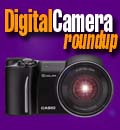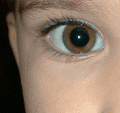The annual international convention and trade show of PMA—the Photo Marketing Association—took place March 3-5 at the Las Vegas Convention Center this year. This is perhaps the second most important photography and imaging trade show in the world, after Germany's Photokina.

This was the 85th annual show and it was a fairly sizable affair with attendees from almost 100 nations, 200 sessions, 400 speakers, and more professional photographers and retail photo store representatives than in prior years. 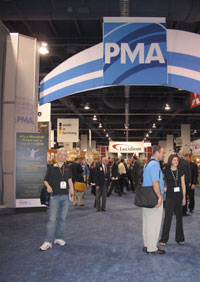 The show occupied most of both levels of the massive South Hall and also included the anual conferences of DIMA (Digital Imaging Marketing Association), PSPA (Professional School Photographers Association International), SPAA (Sports Photographers Association of America), PPFA (Professional Picture Framers Association), and PSRO (Professional Scrapbook Retailers Organization), as well as the PIEA (Photo Imaging Education Association) education conference, with receptions and many conference sessions and meetings held at the Renaissance Las Vegas Hotel.
The show occupied most of both levels of the massive South Hall and also included the anual conferences of DIMA (Digital Imaging Marketing Association), PSPA (Professional School Photographers Association International), SPAA (Sports Photographers Association of America), PPFA (Professional Picture Framers Association), and PSRO (Professional Scrapbook Retailers Organization), as well as the PIEA (Photo Imaging Education Association) education conference, with receptions and many conference sessions and meetings held at the Renaissance Las Vegas Hotel.
Press registration was a bit of a logistical issue as media, pre-registered or not, had to prove they were, in fact, media. For the print crowd that meant arriving prepared with a magazine that contained a story or feature with a name. For the increasing number of online reporters it meant, well, a link or URL or printout of a story. IPhone to the rescue as calling up one of our features satisfied the friendly registration staff.
Roaming around the PMA show floors is always an experience. Downstairs was the big boys with their mega booths—Nikon, Canon, Fujifilm, Pentax, Olympus, Sony, Kodak, Casio, Samsung, HP, Panasonic and so on—whereas upstairs was filled with hundreds of smaller exhibitors. That's where you often find the pearls, the really cool and interesting stuff.
In no particular order, we saw:
 Custom Brackets was founded because there are many situations where commercial brackets just don't quite fit the bill. They may be too large or heavy or don't have the functionality needed. Crafted of black anodized aluminum, the brackets are very light and let you do all the rotating and mounting on a large variety of leading professional cameras. A patented rotation system with special roller bearings really adds functionality. What impressed me most about Custom Brackets was that every part and every detail looked like a lot of thought had gone into its design. The result are brackets that do the job without getting in the way or weighing a ton. (www.custombrackets.com)
Custom Brackets was founded because there are many situations where commercial brackets just don't quite fit the bill. They may be too large or heavy or don't have the functionality needed. Crafted of black anodized aluminum, the brackets are very light and let you do all the rotating and mounting on a large variety of leading professional cameras. A patented rotation system with special roller bearings really adds functionality. What impressed me most about Custom Brackets was that every part and every detail looked like a lot of thought had gone into its design. The result are brackets that do the job without getting in the way or weighing a ton. (www.custombrackets.com)
The folks at Trek-Tech specialize in all sorts of camera tripods and mounting gear for photographers on the go. There are unusual looking mounts that sit on your shoulder, attach to trees or rocks or whatever. We especially liked a carbon fiber "TrekPod" that looked like a high-tech walking stick but opened up to become a full tripod. The whole thing weighed just 22 ounces and is fully adjustable from 39 to 62.5 inches as a monopod or tripod. It breaks down to fit in carry-on luggage, and comes complete with sturdy travel case, albeit at a fairly steep US$399. (www.trek-tech.com)
Being scuba divers, we liked what we saw at Epoque USA, part of Epoque World Company, Ltd. of Japan. They make underwater housings for a variety of current cameras, both still and video. They have the impressive Epoque EHD-1000 HD system for the Sanyo Xacti VPC HD1000 and VPC-1010 1080p high def cameras, including strobes, lights, wide angle lenses, fiber connects, and numerous filters. The 150-foot rated housing costs US$449 and will now also accommodate the Sanyo Xacti VPC-2000. They also have underwater high-power LED lights that fit right on top of most underwater housings. (www.epoque-japan.com and www.epoqueusa.com)
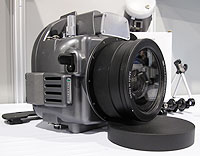 We met with the Epoque folks again on our second day at the show and had a full demo of their new deepwater housing for the Canon Rebel XT and Xti. It's a compact and most impressive housing that can even accommodate an open pop-up flash, You can also use the optical viewfinder. Design and execution are flawless. We met with Mr. Nori Nakano, the company's president who is a diver as well. The US representative once handled the Nikonos line in the US. Those guys clearly know underwater photography and video.
We met with the Epoque folks again on our second day at the show and had a full demo of their new deepwater housing for the Canon Rebel XT and Xti. It's a compact and most impressive housing that can even accommodate an open pop-up flash, You can also use the optical viewfinder. Design and execution are flawless. We met with Mr. Nori Nakano, the company's president who is a diver as well. The US representative once handled the Nikonos line in the US. Those guys clearly know underwater photography and video.
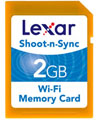 The game-changing Eye-Fi wireless SD card is now available under the Lexar brand as well. The Lexar Shoot-n-Sync 2GB card runs US$117. Eye-Fi, meanwhile, offers a new 4GB version of the card. For those not familiar with the Eye-Fi card, it's a memory card that also has WiFi built-in, giving any camera that uses SD cards wireless capabilities. Unlike regular memory cards, it allows you to automatically, effortlessly, and wirelessly upload photos via your WiFi network either to your PC, or onto photo-sharing or social networking websites. We've been using them ever since they came out. (www.eye.fi)
The game-changing Eye-Fi wireless SD card is now available under the Lexar brand as well. The Lexar Shoot-n-Sync 2GB card runs US$117. Eye-Fi, meanwhile, offers a new 4GB version of the card. For those not familiar with the Eye-Fi card, it's a memory card that also has WiFi built-in, giving any camera that uses SD cards wireless capabilities. Unlike regular memory cards, it allows you to automatically, effortlessly, and wirelessly upload photos via your WiFi network either to your PC, or onto photo-sharing or social networking websites. We've been using them ever since they came out. (www.eye.fi)
 Pro Cyc offers the MyStudio line of product photography shooting photo "cyclorama" backdrops and lights to do perfect shots of whatever needs the "studio photography" treatment for optimal product shots for eBay, online merchants, catalogs and more. The design is based on many years of studio photography experience and comes in several sizes. The result is professional quality shots every time. Having done many ad-hoc hundreds of product shoots for our magazines and websites, I can appreciate a handy little setup like this. (www.procyc.com)
Pro Cyc offers the MyStudio line of product photography shooting photo "cyclorama" backdrops and lights to do perfect shots of whatever needs the "studio photography" treatment for optimal product shots for eBay, online merchants, catalogs and more. The design is based on many years of studio photography experience and comes in several sizes. The result is professional quality shots every time. Having done many ad-hoc hundreds of product shoots for our magazines and websites, I can appreciate a handy little setup like this. (www.procyc.com)
 Ever-increasing storage is everywhere, and yet we never cease to be amazed at just how much storage one can get these days for little money. A company named Hyperdrive makes blindingly fast memory card backup and photo viewers. Their Colorspace UDMA backs up a full 2GB card in a minute, has a high-res 3.2-inch LCD for viewing, offers advanced file management and searching, supports 14 memory card types, does RAW decoding, and offers up to half a terabyte of storage and more. Yet, the thing only weighs ten ounces. (www.hyperdrive.com)
Ever-increasing storage is everywhere, and yet we never cease to be amazed at just how much storage one can get these days for little money. A company named Hyperdrive makes blindingly fast memory card backup and photo viewers. Their Colorspace UDMA backs up a full 2GB card in a minute, has a high-res 3.2-inch LCD for viewing, offers advanced file management and searching, supports 14 memory card types, does RAW decoding, and offers up to half a terabyte of storage and more. Yet, the thing only weighs ten ounces. (www.hyperdrive.com)
There were dozens or hundreds of vendors offering digital album creation software and paraphernalia. The goal is to get the job done quickly, efficiently, yet with novel and pleasing results. An interesting product we saw was Dg Foto Art Gold by PXL Soft. It does some image editing and enhancement, and excels in backgrounds, templates and decoration. (www.pxlsoft.com)
Alpine Innovations does eye-catching and very useful protective carry baggies and pouches for small items. They keep optics secure and dry, and many of the baggies include very cleveryly made microfiber lens cloth pouches so you can get the smudges off your phone or camera. (www.alpineproducts.com)
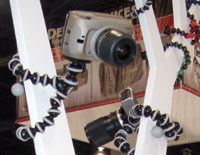 Also an eyecatcher, and a very useful one at that, is the Joby Gorillapod. It's the lightest and most versatile camera tripod we've ever seen. It looks different, too, consisiting of dozens of colorful leg joints that can all be bent and wrapped any which way. This means that the Gorillapad is not just a regular tripod, but a universal stand/attachment system that lets you place a camera (or phone or HPS or game console) just right, even if that means it needs to attach to a pole, a branch, in a car, etc. (www.joby.com)
Also an eyecatcher, and a very useful one at that, is the Joby Gorillapod. It's the lightest and most versatile camera tripod we've ever seen. It looks different, too, consisiting of dozens of colorful leg joints that can all be bent and wrapped any which way. This means that the Gorillapad is not just a regular tripod, but a universal stand/attachment system that lets you place a camera (or phone or HPS or game console) just right, even if that means it needs to attach to a pole, a branch, in a car, etc. (www.joby.com)
PR dynamo Scott Heath of Synergy Communications showed us the latest memory products from Kingston Technology. What with all the different storage card formats used in cameras these days, Kingston's 19-in-1 Flash Memory Reader certainly comes in handy (we have one for each computer in our office and use it every day), and their MobileLite SD and USB Card Reader is invaluable if you deal not only with SD Cards, but also miniSD and microSD. The thing looks like a simple USB key, yet has a dedicated slot for all three card formats. Also interesting was how Kingston is packaging their larger SD cards targeted for video in boxes labeled "240 minutes/16GB -- SDHC Video", reminiscent of the tape people used to use in their camcorders. (kingston.com)
 With all our expensive camera gear, we need bags. Perhaps the best speciality bags we saw this year were by M-Rock. The brainchild of high-energy Michael Rockwell, these bags are simply a cut above just about anything else out there. No matter which bag we looked at, Michael explained the rationale behind it, showed us numerous ways in which the bag was better, more versatile, tougher, and more configurable than anything we've seen. The system is totally modular. Awesome! (www.m-rock.com)
With all our expensive camera gear, we need bags. Perhaps the best speciality bags we saw this year were by M-Rock. The brainchild of high-energy Michael Rockwell, these bags are simply a cut above just about anything else out there. No matter which bag we looked at, Michael explained the rationale behind it, showed us numerous ways in which the bag was better, more versatile, tougher, and more configurable than anything we've seen. The system is totally modular. Awesome! (www.m-rock.com)
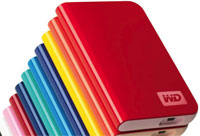 When people hear "Western Digital," they generally think of hard drives. That is indeed the company's business, but these days that means a whole lot more than just drives in computers. Western Digital now has a large lineup of elegantly designed storage products like the "My DVR Expander" that works with DVRs, the "WD ShareSpace" with up to 4 terabyte of capacity, the "My Book" external storage products, the "My Passport Studio" for Macs, and just about anything else to add storage space and keep your data and pictures safe with convenient, attractive backup solutions. (www.westerndigital.com)
When people hear "Western Digital," they generally think of hard drives. That is indeed the company's business, but these days that means a whole lot more than just drives in computers. Western Digital now has a large lineup of elegantly designed storage products like the "My DVR Expander" that works with DVRs, the "WD ShareSpace" with up to 4 terabyte of capacity, the "My Book" external storage products, the "My Passport Studio" for Macs, and just about anything else to add storage space and keep your data and pictures safe with convenient, attractive backup solutions. (www.westerndigital.com)
 The Lenmar folks seem to have absolutely everything needed to make sure you never run out of power for all those portable electronics we have come to depend on. They've been doing this sort of thing for 43 years or so, and it shows. They pride themselves in not only providing power, but also innovative new solutions to make sure you never run out of it. There are special clips that snap onto just about any camera or phone battery and let you charge it via USB. They also have cool stuff like the PowerPort Solar charger & battery, and their PowerPort chargers that connect and adapt to about anything. (www.lenmar.com)
The Lenmar folks seem to have absolutely everything needed to make sure you never run out of power for all those portable electronics we have come to depend on. They've been doing this sort of thing for 43 years or so, and it shows. They pride themselves in not only providing power, but also innovative new solutions to make sure you never run out of it. There are special clips that snap onto just about any camera or phone battery and let you charge it via USB. They also have cool stuff like the PowerPort Solar charger & battery, and their PowerPort chargers that connect and adapt to about anything. (www.lenmar.com)
 Ewa-marine, a German company that has been making underwater housings for cameras since 1970, showed a very interesting approach to underwater photography. It's basically sealed baggies that can be used for anything from iPhones to digital SLRs. Some had integrated lens fittings, some have air valves, and they work to varying depths, depending on construction. Amazing. We saw a model for a Nikon dSLR including flash on top, and it works to 150 feet. (www.ewa-marine.de)
Ewa-marine, a German company that has been making underwater housings for cameras since 1970, showed a very interesting approach to underwater photography. It's basically sealed baggies that can be used for anything from iPhones to digital SLRs. Some had integrated lens fittings, some have air valves, and they work to varying depths, depending on construction. Amazing. We saw a model for a Nikon dSLR including flash on top, and it works to 150 feet. (www.ewa-marine.de)
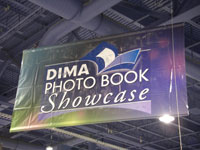 A special section was reserved for photobooks. Photobooks is a terrific way to not only print and preserve pictures, but to do so in style and a format that resonates with a lot of people. There are a lot of companies offering photobook services, from your local drugstore to consumer photography companies and all the way to businesses that specialize in very sophisticated or artistic photobook creations with special effects and backgrounds. Some of the companies that showed their products were Unibind, Inc. (unibind.com), SyNet Media (photopublishing.net), DigiLabs, Inc. (digilabstech.com), Noritsu Koki Co., Ltd. (noritsu.co.jp), MGI USA, Inc. (mgiusa.com), Embassy Digital (embassydigital.com), CVS, HP, etc..
A special section was reserved for photobooks. Photobooks is a terrific way to not only print and preserve pictures, but to do so in style and a format that resonates with a lot of people. There are a lot of companies offering photobook services, from your local drugstore to consumer photography companies and all the way to businesses that specialize in very sophisticated or artistic photobook creations with special effects and backgrounds. Some of the companies that showed their products were Unibind, Inc. (unibind.com), SyNet Media (photopublishing.net), DigiLabs, Inc. (digilabstech.com), Noritsu Koki Co., Ltd. (noritsu.co.jp), MGI USA, Inc. (mgiusa.com), Embassy Digital (embassydigital.com), CVS, HP, etc..

Geotagging attracted some attention. A German company by the name of foolography showed a tiny module that snaps onto late model Nikons (and perhaps other cameras) and then communicates with any commercially available GPS system/puck. The camera will automatically add the location data to the file's metadata. Another approach was shown by GoBoGPS, which showed a small GPS module that uses any camera's hotshoe. It then somehow adds GPS data to files and makes that data available via supplied software once the pictures are loaded to a computer. (foolography.com and gogogps.biz)
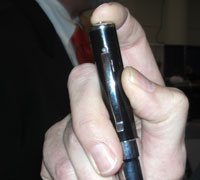 In my youth, the epitomy of cool spy camera equipment came from a German company called Minox. They made an impossibly small stick of a camera that used special film. Well, Minox is still around and they now make a digital era lookalike of the old Minox. They also still make spy gear, with cameras inside pens and such. The Minox Digital Pen Camera looks just like a classy pen, but includes a video camera that records realtie in AVI format. They also have an underwater camera with a stainless steel body, the 8-megapixel Minox DC8022WP. It can go down to 33 feet. (www.minox.com)
In my youth, the epitomy of cool spy camera equipment came from a German company called Minox. They made an impossibly small stick of a camera that used special film. Well, Minox is still around and they now make a digital era lookalike of the old Minox. They also still make spy gear, with cameras inside pens and such. The Minox Digital Pen Camera looks just like a classy pen, but includes a video camera that records realtie in AVI format. They also have an underwater camera with a stainless steel body, the 8-megapixel Minox DC8022WP. It can go down to 33 feet. (www.minox.com)
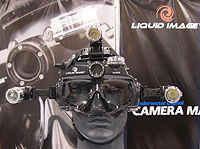 The folks at Liquid Image are doing something different with their Video Mask. It is a standard scuba diving mask combined with a digital still and video camera. The camera mask is the brainchild of Kent Pearson, a former Xircom and Intel engineer who is well versed in dreaming up, and implementing, seemingly impossible products. There are versions for just snorkeling and others that you can take diving down to below 100 feet, and a "professional" version for really deep dives. We actually ended up doing a real-life review and the video mask worked great (see our "review of the Liquid Image VideoMask)
The folks at Liquid Image are doing something different with their Video Mask. It is a standard scuba diving mask combined with a digital still and video camera. The camera mask is the brainchild of Kent Pearson, a former Xircom and Intel engineer who is well versed in dreaming up, and implementing, seemingly impossible products. There are versions for just snorkeling and others that you can take diving down to below 100 feet, and a "professional" version for really deep dives. We actually ended up doing a real-life review and the video mask worked great (see our "review of the Liquid Image VideoMask)
Frankly, we could have spent days in the upper hall looking at all the cool stuff, but now it was time to go downstairs and see what the big boys were up to!
Canon was there in massive force, and it looks like they're going for undisputed leader and #1 in the digital photography market. Canon had the largest booth by far, right at the entrance, and a gorgeous series of displays highlighting their latest EOS digital SLRs and ever-increasing variety of Powershot models.

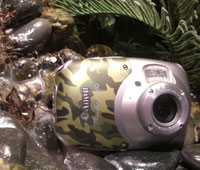 With waterproof, shockproof and freezeproof cameras suddenly everywhere these days, Canon went to great lengths to highlight their new PowerShot D1, a playfully designed 12-megapixel camera waterproof to 33 feet. It's an interesting first effort, but with the small display and lack of multiple underwater modes and a wid angle lens, it's clear that Canon is playing catchup to the likes of Olympus and Pentax.
With waterproof, shockproof and freezeproof cameras suddenly everywhere these days, Canon went to great lengths to highlight their new PowerShot D1, a playfully designed 12-megapixel camera waterproof to 33 feet. It's an interesting first effort, but with the small display and lack of multiple underwater modes and a wid angle lens, it's clear that Canon is playing catchup to the likes of Olympus and Pentax.
On the other hand, Canon's growing family of EOS Rebel cameras is most impressive. It seems like only yesterday that the first Rebel broke the US$1,000 mark, and now you have your choice of very high quality dSLRs for much less.
The"Digital ELPH" series contibues to dazzle with quality, features and high style. The tiny 12.1-megapixel Powershot SD780 IS, all red down to a red-anodixed lens barrel, is drop-dead gorgeous. The Powershot G10, though introduced before PMA, continues to be perhaps the overall best digital compact (hey, it was my camera of choice to bring to the show), and at th elow end you can now get 10-megapixel Canon PowerShot power in the new A480 that lists for just US$129. (www.canonusa.com)
Fujifilm showed, among many other new cameras, the waterproof FinePix Z33WP. It is much smaller when you see it in person than it looks in pictures. It's tiny! I tried the soft buttons in the back and they feel fine. One problem is that it's hard to get used to navigation keys that are not in a diamond arrangement. Also, the Z33WP is waterproof only to ten feet, not 33 as one might deduce from its name. I tried to explain why the naming is confusing, but without much success.
 We talked to our friends at Olympus who went all out demonstrating their lineup of tough waterproof cameras. Some of the cameras are just waterproof, such as the new 10-megapixel Stylus 550WP, whereas others are also freezeproof, shockproof—like the new Stylus Tough 6000—and even crushproof on top of all that, like the Stylus Tough 8000. Olympus had a pool set up where people could drop the cameras and see they were indeed waterproof. They also had three cameras frozen into a large block of ice (see below left), and separate toughness demonstration including a crush press (see below right) and a drop demo. Olympus also showed their new E-620 dSLR and its waterproof housing. The cool thing is that its live view LCD actually looks at the world with the mirror up, just like what you see through the viewfinder.
We talked to our friends at Olympus who went all out demonstrating their lineup of tough waterproof cameras. Some of the cameras are just waterproof, such as the new 10-megapixel Stylus 550WP, whereas others are also freezeproof, shockproof—like the new Stylus Tough 6000—and even crushproof on top of all that, like the Stylus Tough 8000. Olympus had a pool set up where people could drop the cameras and see they were indeed waterproof. They also had three cameras frozen into a large block of ice (see below left), and separate toughness demonstration including a crush press (see below right) and a drop demo. Olympus also showed their new E-620 dSLR and its waterproof housing. The cool thing is that its live view LCD actually looks at the world with the mirror up, just like what you see through the viewfinder.
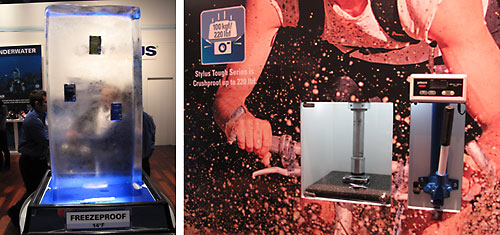
Extending its new Stylus camera numbering system, Olympus also introduced the US$299 Stylus-7000 with 7x 37-260 optical zoom and the US$349 Stylus-9000 with a 10x wide-angle 28-280mm zoom, both with 12-megapixel imagers and dual image stabilization. There's also a long-zoom race that's been going on almost since the dawn of digital cameras, and Olympus has always been either the leader or a strong contender in that race. The latest entry is the SP-590UZ, a 12-megapixel camera with a mind-boggling 26x wide-angle optical zoom with a range of 26-676 mm equivalent. (www.olympusamerica.com)
General Electric made a statement with a waterproof camera as well, having some of the 10-foot-rated G3WP them sit in a tank of water. GE's cameras are handled by worldwide exclusive licensee General Imaging, located in California. Though we really haven't heard much from GE/General Imaging, this is really already GI's third year. There's a complete lineup of 9-12 megapixel cameras with the usual variety of zooms and medley of features. There's also a touch-screen model. Overall, a competent but perhaps a bit bland lineup of entry-level point & shoot cameras at very competitive prices (starting at US$89 or so). It is not entirely obvious to see why General Electric is in this market, or how they intend to make money in it.
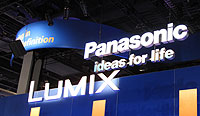 Panasonic also had a large display dedicated to the new dust and waterproof camera. They had one sit under the wheel of a ATV, in dirt and water (see below). The attractive camera, the Lumix DMC-T1, is available in several colors, can handle ten feet of water AND has a 4.6x zoom that starts wide at 28mm. This could be a strong contender to the Olympus, albeit at a rather high price (US$399). Another large display was dedicated to the new 12.1-megapixel Lumix DMC-GH1, a most impressive camera based on the micro-four thirds system, which means this is a compact with exchangeable lenses. It looks stunning, too, especially in red, and it can even record 1920 x 1080 pixel 1080p video at 24fps. Panasonic showed how the glass lenses are arranged in some of their lenses. This graphically demonstrated how lenses are arranged in groups, something that I had always wondered anout. (Panasonic)
Panasonic also had a large display dedicated to the new dust and waterproof camera. They had one sit under the wheel of a ATV, in dirt and water (see below). The attractive camera, the Lumix DMC-T1, is available in several colors, can handle ten feet of water AND has a 4.6x zoom that starts wide at 28mm. This could be a strong contender to the Olympus, albeit at a rather high price (US$399). Another large display was dedicated to the new 12.1-megapixel Lumix DMC-GH1, a most impressive camera based on the micro-four thirds system, which means this is a compact with exchangeable lenses. It looks stunning, too, especially in red, and it can even record 1920 x 1080 pixel 1080p video at 24fps. Panasonic showed how the glass lenses are arranged in some of their lenses. This graphically demonstrated how lenses are arranged in groups, something that I had always wondered anout. (Panasonic)

At Pentax we saw that cool, compact and white-bodied 10.2-megapixel K2000 again (we'd fallen in love with it at the Digital Focus press event the night before). It looks like a Star Wars Stormtrooper camera. 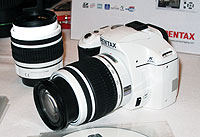 It's interesting how attractive limited edition gizmos are. After having used a Pentax K10D for a couple of years, we liked the white K2000 so much that we actually bought one for the office! Color, in general, seems a big draw. There were more colorful compacts than ever before, some with extremely elegant looking anodized lens barrels. But all SLRs remain black. Except the limited edition Pentax K2000. Also interesting is the new Pentax X70, a 12-megapixel camera with a 26-624mm 24x optical zoom and - good thing - triple shake reduction technology. The Optio lines added the US$ 139 E70 and US$ 199 P70, handsome little 12-megapixel models available in elegant colors. (www.pentaximaging.com)
It's interesting how attractive limited edition gizmos are. After having used a Pentax K10D for a couple of years, we liked the white K2000 so much that we actually bought one for the office! Color, in general, seems a big draw. There were more colorful compacts than ever before, some with extremely elegant looking anodized lens barrels. But all SLRs remain black. Except the limited edition Pentax K2000. Also interesting is the new Pentax X70, a 12-megapixel camera with a 26-624mm 24x optical zoom and - good thing - triple shake reduction technology. The Optio lines added the US$ 139 E70 and US$ 199 P70, handsome little 12-megapixel models available in elegant colors. (www.pentaximaging.com)
Sony continues to go full blast with its camera efforts. They showed their high-end $3,000 Alpha A900 has a 24.6mp full-frame CMOS sensor, a two-sensor live view system and a 3-inch LCD that has 921k pixel. They also stressed high definition. All of their current dSLRs can store pictures in 16:9 widescreen format for optiomal viewing on HDTVs, and some even have mini-HDMI output for pure digital-to-digital connections.
Sony also introduced five new Cyber-shot cameras in snazzy color—the T900, T90, W230, W290, H20, all in the 10-12 megapixel range and including technologies to make the cameras smarter in recognizing shooting conditions and automatically selecting the best settings.
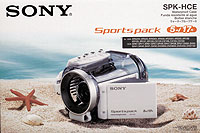 With high definition everywhere, it's becoming pretty difficult to sell anything that does NOT shooting at least in 720p HD video, with everything gravitating to full 1080p 1920 x 1080 resolution. There's a flood of very inexpensive vidcams that can do that, and Sony decided to enter that low end as well with their MHS-CM1 and MHS-PM1 "Webbie HD" vidcams. The colorful little cameras with the odd name weigh just four ounces, only have digital zoom, but can do 1440 x 1080 video at 30fps and shoot 5mp stills. In keeping with the emphasis on waterproof and underwater cameras, Sony also showed a number of underwater housings for many of their cameras and vidcams.
With high definition everywhere, it's becoming pretty difficult to sell anything that does NOT shooting at least in 720p HD video, with everything gravitating to full 1080p 1920 x 1080 resolution. There's a flood of very inexpensive vidcams that can do that, and Sony decided to enter that low end as well with their MHS-CM1 and MHS-PM1 "Webbie HD" vidcams. The colorful little cameras with the odd name weigh just four ounces, only have digital zoom, but can do 1440 x 1080 video at 30fps and shoot 5mp stills. In keeping with the emphasis on waterproof and underwater cameras, Sony also showed a number of underwater housings for many of their cameras and vidcams.
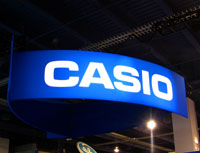 We stopped by Casio to see their new high-speed cameras in action and I ran into a Scott Nelson, one of my old friends at Casio. Scott has been with Casio forever and he's been a terrific source of information throughout the years. There are few people as knowledgeable and enthusiastic about their products as Scott, and he does one hell of a presentation. Ever staying ahead of the curve, Casio secured the appropriate CCD to handle high speed, then created a custom chip to handle whatever processing was necessary to make the incredible speed of the Casio F1 possible. They then put that technology into a more consumer-oriented camera, the FH20 with its long zoom, and now into the two new F Series cameras. I was blown away by the sheer wealth of clever features that is simply a cut above everyone else. Amazing.
We stopped by Casio to see their new high-speed cameras in action and I ran into a Scott Nelson, one of my old friends at Casio. Scott has been with Casio forever and he's been a terrific source of information throughout the years. There are few people as knowledgeable and enthusiastic about their products as Scott, and he does one hell of a presentation. Ever staying ahead of the curve, Casio secured the appropriate CCD to handle high speed, then created a custom chip to handle whatever processing was necessary to make the incredible speed of the Casio F1 possible. They then put that technology into a more consumer-oriented camera, the FH20 with its long zoom, and now into the two new F Series cameras. I was blown away by the sheer wealth of clever features that is simply a cut above everyone else. Amazing.

A few more thoughts on Casio's approach: While the ever-lower prices of digital cameras are good news for consumers, they mean ever lower margins for those who make them. For a while, the premium brands distinguished themselves with cool new features, and they continue doing so, but by now almost everyone and almost every camera has face recognition, onboard editing, and other tricks. Casio is one company that's always been a bit ahead of the curve with innovation, and they realized they needed to differentiate themselves in new and different ways. So they are now into speed. Last year they introduced the hyper-fast (and rather expensive) Casio F1 that could shoot at an incredible number of frames per second and even use that to create stunning slow-motion video. They are now adding this sort of speed to their point & shoot ultra-compacts. The EX-FC100 (5X zoom) and the ultra-thin 3X zoom EX-FS10 can both capture 30 6-megapixel frames per second. So now Casio offers four F-Series high speed cameras, the two new ones and the F1/FH20. They also showed three new cameras including the super-slim US$299 EX-Z400 with 4X wide-angle zoom and 720p HD video.
Interestingly, I probably saw more underwater cameras and underwater housings both for still cameras and for video cameras than at DIMA, the PMA equivalent of the scuba diving industry. While some of the big names (Olympus, Panasonic, Canon, Fuji) highlighted the waterproof cameras, most of the companies selling housing are small importers.
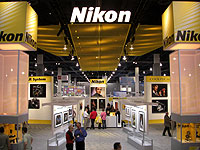 Nikon, of course, had a giant presence. The company that once was instrumental in putting digital imaging on the map with its original Coolpix cameras now has a full lineup of compacts, SLRs, and some specialty cameras. The compact, colorful Coolpix cameras cover all the bases without being different or special as the Coolpix line once was. That is not necessarily a bad thing, though a bit more differentiation among the leaders would be nice. It is quite clear that Nikon makes the big bucks with the digital SLRs, though.
Nikon, of course, had a giant presence. The company that once was instrumental in putting digital imaging on the map with its original Coolpix cameras now has a full lineup of compacts, SLRs, and some specialty cameras. The compact, colorful Coolpix cameras cover all the bases without being different or special as the Coolpix line once was. That is not necessarily a bad thing, though a bit more differentiation among the leaders would be nice. It is quite clear that Nikon makes the big bucks with the digital SLRs, though.  A decade after the timid (yet expensive) first attempts at digital SLRs, Nikon has no fewer than eight dSLR lines, ranging from the compact D40 all the way to the mighty D3. It's a different world from the one of slender little ultra-things that fit into any pocket. Nikon, like some others, had several displays that showed the insides and components of the camera. It is quite interesting to see the bare magnesium body of a big Nikon dSLR. I truly had no idea they were that rugged and complex. (imaging.nikon.com)
A decade after the timid (yet expensive) first attempts at digital SLRs, Nikon has no fewer than eight dSLR lines, ranging from the compact D40 all the way to the mighty D3. It's a different world from the one of slender little ultra-things that fit into any pocket. Nikon, like some others, had several displays that showed the insides and components of the camera. It is quite interesting to see the bare magnesium body of a big Nikon dSLR. I truly had no idea they were that rugged and complex. (imaging.nikon.com)
JVC's display caught my eye because of the nice, friendly way they displayed their cameras. They were all sitting around fruits and pasta and all sorts of other delicious looking foods. Very colorful and lively. 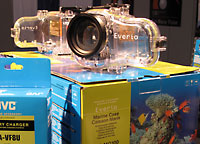 The JVC Everio cams come in three flavors, the HD Everio, the Everio G and the Everio S. The Everio HD does full 1920x1080 high def video and records on a 60 or 120GB hard disk or onto SD cards. The Everio G and Everio S differ primarily in their recording medium, hard disk or SD card, and their highest recording rate is 832 x 624 pixel. There is an impressive underwater housing available as well. Nice touch: some models have dual SD card slots. There's also an entirely new US$999 model that is more angular and looks more professional. It records at full HD and can also do high-res stills. (JVC)
The JVC Everio cams come in three flavors, the HD Everio, the Everio G and the Everio S. The Everio HD does full 1920x1080 high def video and records on a 60 or 120GB hard disk or onto SD cards. The Everio G and Everio S differ primarily in their recording medium, hard disk or SD card, and their highest recording rate is 832 x 624 pixel. There is an impressive underwater housing available as well. Nice touch: some models have dual SD card slots. There's also an entirely new US$999 model that is more angular and looks more professional. It records at full HD and can also do high-res stills. (JVC)

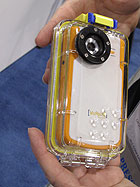 A Florida company called VuPoint Solutions showed a variety of interesting stuff. Their big seller is a small US$149 box that you use to copy old negatives into 5mp images. Since the device actually takes a picture as opposed to scanning it is blindingly fast and the quality is very good. It has a 2.7-inch LCD display, so no need to hook it up while backing up those irreplaceable slides or film negatives. They also had an inexpensive video camera with a USB jack that costs US$99 including an underwater housing (good for 50 feet or so) and a 5mp camera at the same price and depth rating. (VuPoint Solutions)
A Florida company called VuPoint Solutions showed a variety of interesting stuff. Their big seller is a small US$149 box that you use to copy old negatives into 5mp images. Since the device actually takes a picture as opposed to scanning it is blindingly fast and the quality is very good. It has a 2.7-inch LCD display, so no need to hook it up while backing up those irreplaceable slides or film negatives. They also had an inexpensive video camera with a USB jack that costs US$99 including an underwater housing (good for 50 feet or so) and a 5mp camera at the same price and depth rating. (VuPoint Solutions)
Overall, PMA 2009 was a lot more interesting than I expected. There'd been times in the past when the show had been a bit... stuffy, and I always attributed that to a lingering resentment that digital photography was coming on so strong and was about to challenge film. Now that the film versus digital battle is over and digital has won, almost everyone seems to fully embrace the new technology and its vast potential.
In the bigger scheme of things, digital photography is really still in its infancy and the best is yet to come. The possibilities are endless. I did see a litte bit of stagnation this year, with many products relying on snazzy colors and electronic gimmicks rather than real progress. Face recognition, funny editing tricks, and waterproof cameras are all good and well, and we certainly like the lower prices, but it is true innovation that will—and has to—drive this industry.
Report by Conrad H. Blickenstorfer; photography by Carol
Cotton
